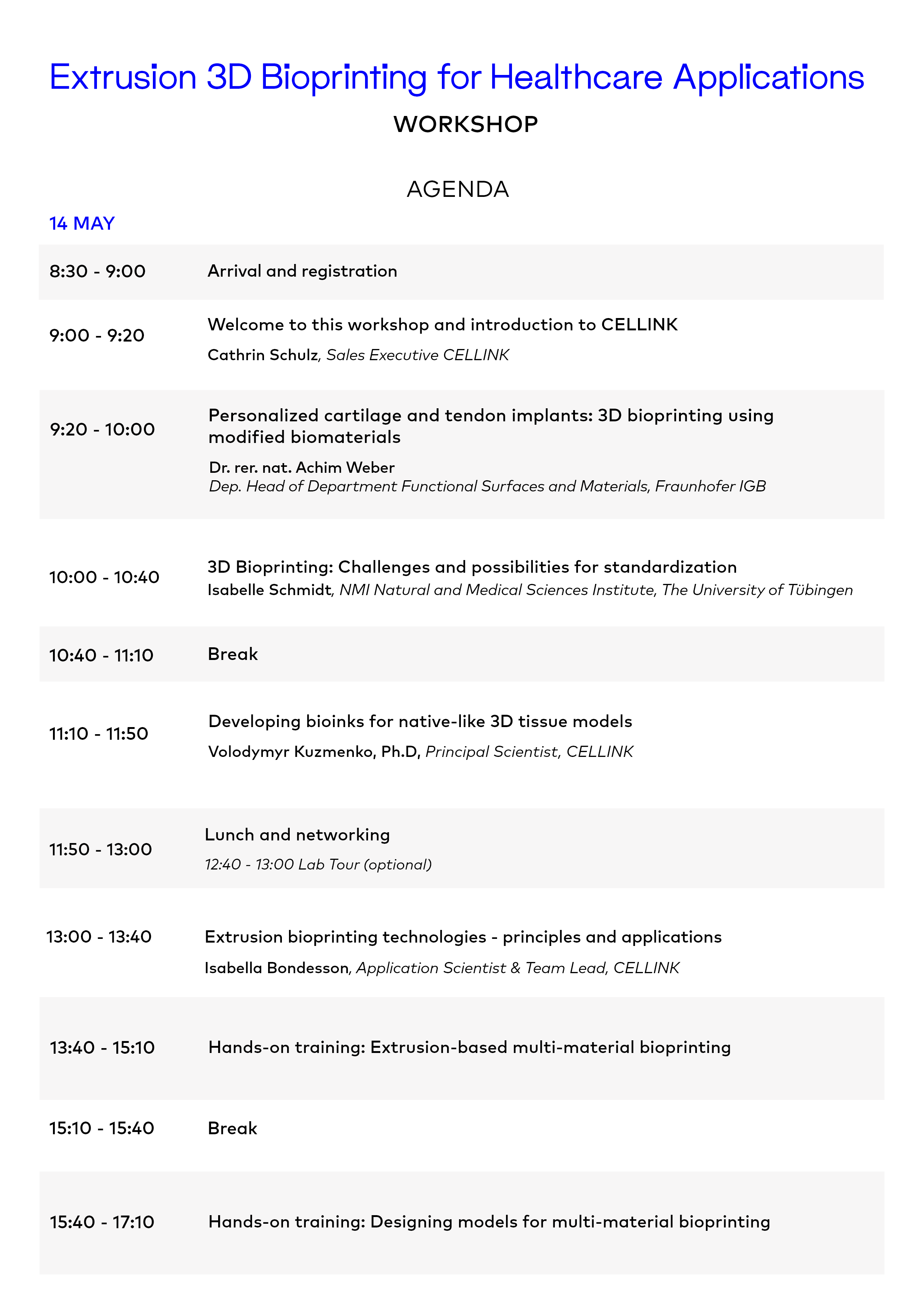Workshop: Extrusion 3D Bioprinting for Healthcare Applications
Location
Fraunhofer Institute for Interfacial Engineering and Biotechnology IGB
Nobelstr. 12
70569 Stuttgart, Germany.
Time
All day
Date
14 May
Regular Ticket
€30
Late Reg. (1 May - 6 May)
€40
At CELLINK, we are dedicated to advancing bioprinting and 3D cell culture. Join us for an immersive experience where you’ll not only discover the latest innovations but also engage hands-on with our cutting-edge technologies. This workshop delves into the use of 3D bioprinting in developing bioengineered systems for Tissue Engineering, Regenerative Medicine, and other healthcare fields. Learn the basics of extrusion-based bioprinting and explore how this technology creates tissue models mirroring natural cellular environments.
Hear from experts already using bioprinting
Participants will hear from experts already using bioprinting to tackle challenges in different healthcare settings. The presentations will offer a chance to learn about the current uses of the technology, where innovation is driving the field, and what future applications can be expected.
Learn how to fabricate in vitro models through hands-on sessions
Participate in interactive small-group training sessions in the afternoon. Engage in hands-on bioprinting demonstrations and discussions on experimental design and best practices.
At the end of workshop completion, you will receive a digital certificate.
Audience
The workshop is aimed at PhD students, clinicians, and research or application scientists seeking to use bioprinting technologies to develop novel healthcare solutions.
Registration
Due to high demand, we’ve set up a waiting list to accommodate those who are still keen on joining. Being on the waiting list is a great opportunity to secure a spot in case any openings become available. Plus, if demand keeps growing, we’ll plan another session to accommodate everyone’s excitement.
Secure your spot on the waiting list now and be the first to know about any additional openings or sessions we announce.
Programme

DAY 1
8:30-9:00
Arrival and registration
9:00-9:20
Welcome to this workshop and overview of the day
Cathrin Schulz, PhD
Sales Executive, CELLINK
9:20-10:00
Tendon, ligament, and cartilage injuries resulting from aging or athletic activities are prevalent health issues globally. Yet they are often underestimated as contributors to long-term disability, reduced quality of life, and increased healthcare expenses. Although both surgical and non-surgical treatments are available, they come with extended recovery periods, fail to fully restore the natural biological and mechanical functions of the tissues, and may lead to complications due to foreign materials. This result in complex requirements for the 3D bioprinting ink processed during bioprinting, since it must be biocompatible on the one hand, and on the other hand, it should have suitable properties (viscosity, surface tension) for the printing process and determine the material properties of the printed tissue equivalent. To tackle these challenges the effective combination of biomaterials, cells, and 3D bioprinting techniques offers a promising solution to overcome the limitations observed in clinical trials when using simple hydrogen scaffolds. The approach aims to replicate the native extracellular environment of orthopaedic soft tissues, thus providing patients with a long-term less invasive and more efficient method to treat these injuries. In order to replicate the biochemical and mechanical characteristics of healthy cartilage and tendon structures, we developed 3D bioprintable scaffolds using methacrylated biomaterials. These modified biomaterials offer the advantage of flexibility in adjusting the stiffness of the hydrogel scaffolds through the process of photopolymerization. Additionally, they exhibit excellent printability and enable the fabrication of patient-specific, temporally, and spatially controlled multi-layered hydrogel scaffolds.
Dr. rer. nat. Achim Weber
Dep. Head of Department Functional Surfaces and Materials, Fraunhofer IGB
10:00-10:40
The NMI Natural and Medical Sciences Institute in Reutlingen is an independent institute
with focus on application-oriented research at the interface of life sciences and materials science. 3D
bioprinting aims to produce tissue-like structures for personalized organ replacement as well as
reliable model systems for personalized drug screening. Before achieving these ambitious goals,
several challenges must be overcome, such as: definition of biofunctional materials, set-up of a
reproducible printing process and establishment of appropriate analytical methods. Possibilities for
standardization will be presented, based on the VDI 5708 and examples for application will be given
Isabelle Schmidt
NMI Natural and Medical Sciences Institute
at the University of Tübingen
10:40-11:10
Break and refreshments
11:10-11:50
CELLINK pioneered the field of bioinks globally. Our ongoing commitment lies in advancing and making accessible bioinks that enable the creation of functional 3D tissue models. These innovative bioinks are groundbreaking biomaterial solutions that enable culturing human cells in hydrogel environment mimicking native tissues, thus rendering them suitable for applications such as drug screening, cosmetic product testing, and research on disease progression. In this presentation we will share how to develop bioinks, test and leverage them across a range of advanced applications.
Volodymyr Kuzmenko, Ph.D Principal Scientist, CELLINK
11:50 – 13:00
Lunch and Networking
12:40 – 13:00 Lab Tour (optional)
13:00-13:40
Introduction to the technologies and strategies used within extrusion based bioprinting that later will be applied in the hands-on training. Discover how 3D bioprinting can be used in creating in-vivo recapitulating biomimetic models for applications such as drug discovery, immunology, and personalized medicine.
We will discuss current applications leveraging the precision, flexibility and multifunctionality of the latest 3D bioprinting technologies. We will also discuss how these technologies are combined to enable advanced application within both the 3D and 4D space.
Isabella Bondesson,
Application Scientist & Team Lead, CELLINK
13:40 – 15:10
This is the workshop session to deepen your extrusion based bioprinting skills, learn how to utilise your BIO X and BIO X6 bioprinters full capacity by selecting the right tool head for the right application. The session will focus on how to set up and use the BIO X/X6 bioprinter with the different printheads and how to combine different methods of bioprinting to facilitate a multi-material print.
Learn about:
- Optimization of printing parameters for extrusion based bioprinting.
- Multi-material bioprinting and how to tackle different bioink behaviours.
Hosted by the Field Application Specialists, CELLINK
15:10-15:40
Break
15:40-17:10
This workshop session focus on applying the different bioprinting skills acquired in Session 1 to advance your model creation. Learn how to utilise g-coding and DNA Studio 4 to fabricate complex, biomimetic models and how to combine different bioprinting strategies to further advance your 3D modelling.
Learn about:
- Modelling of complex biological models and how to incorporate manual edits.
- FRESH bioprinting and other strategies within bioprinting.
Hosted by the Field Application Specialists, CELLINK


Register your interest
Due to high demand, we’ve set up a waiting list to accommodate those who are still keen on joining. Being on the waiting list is a great opportunity to secure a spot in case any openings become available. Plus, if demand keeps growing, we’ll plan another session to accommodate everyone’s excitement.
Secure your spot on the waiting list now and be the first to know about any additional openings or sessions we announce.





